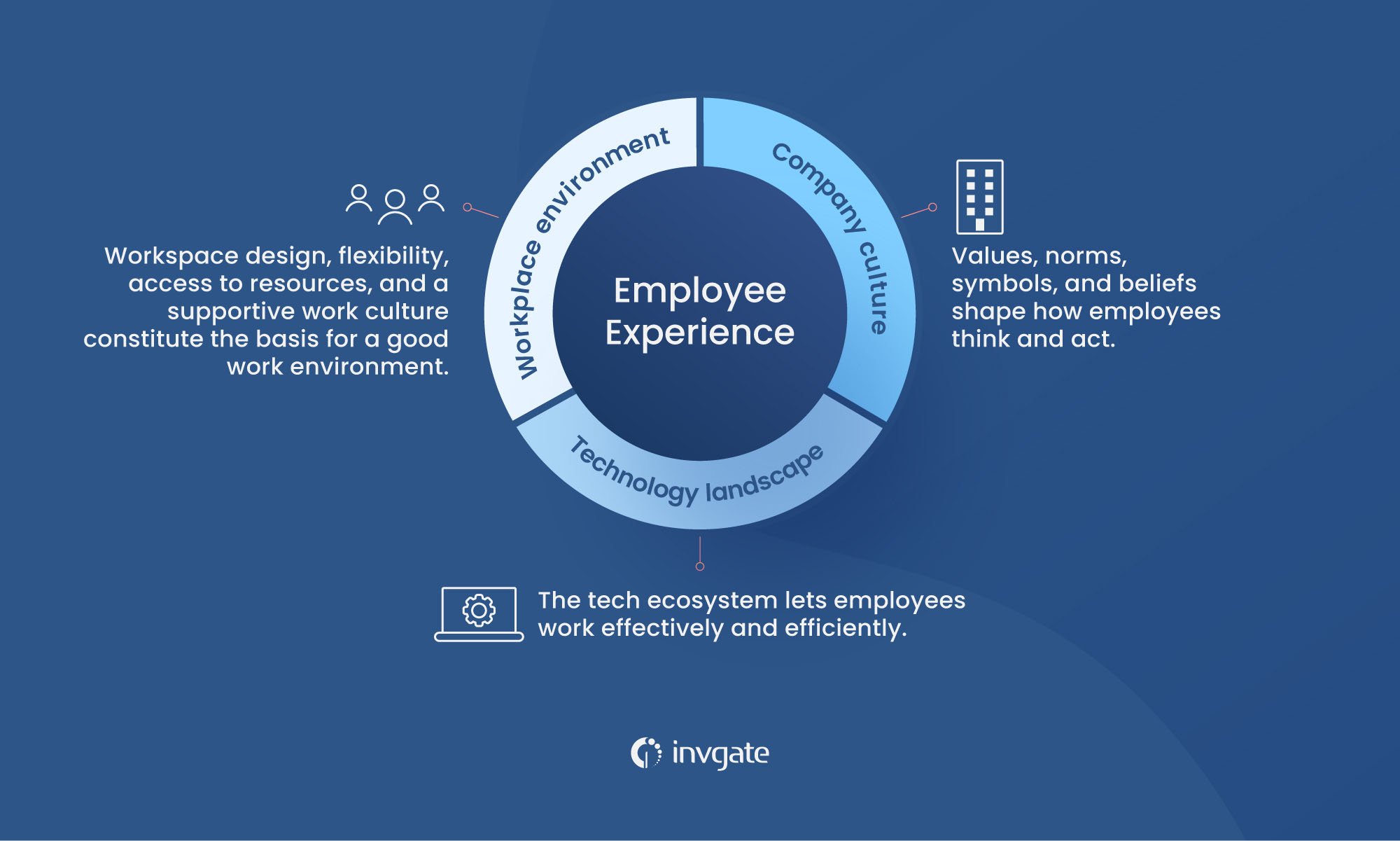Employee experience strategy is designing and implementing an integrated set of activities, initiatives, and programs that collectively create a positive and productive work environment.
Gartner has identified that the employee experience (EX) is about more than just the technology used to enable work - it is about all the interactions employees have throughout their day-to-day work and how their contexts influence these interactions. In this sense, managers are beginning to recognize the importance of designing an optimal employee experience that can help them increase productivity, foster innovation, and attract top talent.
Although IT leaders used to overlook the importance of their employees' experience, now Experience Management is one of the most relevant digital trends of 2023 for a good reason: it gives organizations a competitive edge. So much so that they are taking it to another level by implementing a total experience strategy, impacting leadership positively.
In this article, we'll explain how EX isn't just one thing. It's the combined effect of all areas of an employee's daily and overall experiences at work; hence you'll find a guide to properly implementing your EX strategy - and succeed.
What is an employee experience strategy?
An employee experience strategy is a plan for creating positive, engaging, and meaningful experiences for employees throughout their employment. It looks at how to ensure employees are engaged, motivated, and satisfied with their work environment, and creates a culture that encourages learning, growth, and development.
This strategy focuses on creating a workplace culture where employees feel valued and are given the tools they need to succeed. It also entails providing a comprehensive package of benefits, programs, and services tailored to meet employees' needs. A well-executed employee experience strategy can lead to increased employee engagement, productivity, retention, and satisfaction.
Because of that, it involves assessing the impact of policies, processes, systems, technology, and environment on employee engagement and performance.
The areas or people involved in an employee experience strategy typically include Human Resources, leadership, employees, technology specialists, and other departments within the organization. It’s worth noting that for an effective employee experience strategy, businesses can leverage employee performance management tools. These tools allow them to learn about the employee strengths, get feedback, and align their goals with the company. To make this strategy more effective, managers can also learn a few performance review phrases that can be used to encourage the employees and enhance their productivity.
An employee experience strategy aims to create a workplace that employees look forward to coming to each day and one that they are proud to be a part of. As a result, you get:
- Improved employee engagement: Employee experience strategies can help to create an environment where employees feel connected to the organization and its goals, fostering a sense of loyalty and commitment to the company.
- Improved recruiting and retention: It also builds a stronger emotional connection between the employee and the employer, making it easier for employees to stay with an organization for their careers.
- Reduced turnover: Having a great workplace experience can help to reduce human resource costs, including recruitment, training, and replacement in the long term by making it more likely that employees will want to stay with their company.
- Increased productivity: Staff satisfaction increases motivation, leading to increased productivity from workers who are invested in improving their performance and that of the organization.
- Improved bottom line: An engaged workforce is more productive and loyal to an organization, which translates into increased profitability.
6 steps to implement an employee experience strategy
Before diving in, we would like to remark on the three key factors contributing to an employee's experience: company culture, technology, and engagement.
- Company culture is often defined by a company's values and how those values are put into practice through policies and procedures. Find ways to implement a culture that values your IT teams.
- Technology plays a large role in how employees interact with each other, from communication tools to learning management systems. It requires collaboration between HR and IT teams.
- Finally, engagement is important for keeping employees motivated and connected to the organization as a whole.

With that in mind, this is the employee experience strategy we suggest you implement.
1. Implement people-first culture in your company
A people-first culture is an organizational approach that puts people first regardless of position, seniority, or job title. It is a strategy to create a workplace where employees feel valued, respected, and supported. Crafting a culture that offers personalized support can create a collaborative, trusting atmosphere that further contributes to innovation and productivity. It also enables more meaningful relationships and encourages creativity.
This approach will also help you foster strong employee relationships, increasing employee satisfaction and loyalty. We know from experience that IT teams can find a lot of benefits in this type of implementation.
It is the first step because everyone needs to be on the same page. You must create a culture of mutual aid and support if you want a winning strategy. Let your workers know that is the direction you are going. Establish core values of this culture and communicate them to employees regularly. A way to materialize this is by:
- Encouraging collaboration
- Respecting differences
- Recognizing achievements
- Supporting growth
- Creating communications channels and pathways
2. Collect employee feedback
Not only does employee feedback help you to pinpoint problems in your employee experience strategy, but it can also clue you into areas of employee experience where your organization has the potential to excel.
Ask employees directly for their feedback on the overall experience they have while working at the company. This can be done through surveys, interviews, focus groups, or any other method of gathering information. Moreover, you can leverage InvGate Service Management's features for this purpose (here are a few examples). Many organizations use employee experience software to run a regular employee survey and get actionable insights that can inform HR decisions throughout the employee experience journey.
With the right tools in place, managers can understand what works best for their organization and make necessary changes accordingly. For that to work, there are two aspects you must keep in mind:
- Creating an environment that encourages open dialogue and collaboration from all your team members involved is a great way to foster creativity.
- It's important not to rely solely on you for expertise and decision-making but to share the responsibility to produce the best outcome.
3. Determine areas of improvement
Now, don't think about measuring EX at this point, but focus on building a positive one with the information you have.
Yes, researching employee experience can help you understand what your IT team needs, but taking action is what makes the difference. So, once the data has been collected, it should be analyzed to identify patterns or trends that may indicate areas for improvement within the company, leading to better use of resources and improved overall performance.
Here are some areas of improvement you might find along the way:
- Time management
- Cooperation
- Conflict resolution
- Written communication
- Accepting feedback and constructive criticism
- Flexibility
4. Map the employee journey
A career development map is a great tool for any organization to provide employees with guidance and support to reach their career goals. It outlines each step in the employee journey, from recruitment to training and advancement.
The map provides a comprehensive overview of what needs to be done to make everything better for your teams. So, study how you can assign areas of improvement within them. The map looks like this:
- Recruitment
- Onboarding
- Development
- Retention
- Exit and offboarding
5. Prepare an action plan with clear objectives
After you have identified your goals, create a plan for how you will achieve them. This plan should include elements such as how you will communicate with employees, what resources will be available to them, and how you will measure success.
To do that, keep in mind that your employee experience strategy should be effective for in-office, hybrid, and remote workers. Understand the unique needs of each group. Consider factors such as:
- Time zones
- Preferred communication tools
- Access to resources
- Availability of support
6. Invest in appropriate technology
At last, investing in the right technology is essential to creating an optimal user experience for your teams. This includes providing remote workers the necessary equipment and software to enable them to work as effectively as in-office workers. It is necessary to assess what tools and applications are used, how they are used, and if there are any areas where you can improve the performance of your existing technology infrastructure.
|
|
Greg Sanker |
The optimal way to monitor your company tools, gather information on the employee experience, and identify improvement areas is having a service desk in place. A tool like InvGate Service Management offers a range of features designed to improve employee experiences that HR and management appreciate alike, such as self-service portals, automated workflows, and customizable dashboards. This makes it easier for employees to quickly find the necessary solutions and resolve their issues.

The platform also provides a clear overview of all incidents and service requests, enabling employees to track progress quickly. Additionally, InvGate Service Management's intuitive interface enables employees to view their requests and easily submit new ones. This helps employees to stay on top of their requests, making the entire process more efficient and improving their overall experience.
Key takeaways
Experience management is proving to be a valuable asset for businesses that want to stay ahead in a crowded marketplace.
The steps we recommend focus on creating positive experiences for employees, such as providing them with meaningful work, a supportive work environment, and a culture of recognition. They also encourage innovation and collaboration while ensuring that employees are engaged and productive. Here is what we think managers need to keep in mind:
- Understand what employee experience is and why it matters.
- Know your people, their needs and preferences, and how they want to work.
- Invest in great technology and make sure it's easy to use.
- Make sure your employee experience is aligned with your business objectives and company culture.
- Focus on creating meaningful experiences for employees throughout their journey with your organization.
- Monitor and measure the effectiveness of your employee experience strategy.















